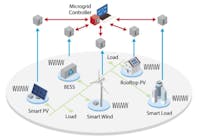DOE Announces New Investments of $30 Million to Protect Critical Infrastructure from Cyber Attack
Energy Secretary Ernest Moniz last week announced awards totaling approximately $30 million for the development of new tools and technologies to strengthen protection of the nation’s electric grid and oil and gas infrastructure from cyber attack.
With support from the Energy Department, energy sector organizations in California, Georgia, New Jersey, North Carolina, Tennessee, Virginia, and Washington State will develop new systems, frameworks, and services that advance the Department’s vision of more resilient energy delivery control systems.
Since 2010, the Department has invested more than $100 million in cybersecurity research and development through awards and funding provided to industry, universities and national laboratories.
The Department claimed it has a long history of working closely with federal, state and industry stakeholders. For example, the Electricity Subsector Cybersecurity Capability Maturity Model (ES-C2M2), which was developed last year as part of a White House initiative led by the Department of Energy in partnership with the Department of Homeland Security, allows electric utilities and grid operators to assess their cybersecurity capabilities and prioritize their actions and investments to improve cybersecurity. The Department, and many industry stakeholders in the energy sector, are also contributing to the development of the Cybersecurity Framework, which was announced as part of Executive Order 13636 on “Improving Critical Infrastructure Cybersecurity.”
All of the Department’s cybersecurity efforts align with the Roadmap to Achieve Energy Delivery Systems Cybersecurity, which was developed by the energy sector in coordination with the Department. The Roadmap outlines a strategic framework over the next decade to design, install, operate, and maintain a resilient energy delivery system capable of surviving a cyber incident while sustaining critical functions.
The eleven projects, which will combine advanced expertise in power system engineering and cybersecurity, will include testing of the new products to demonstrate their effectiveness and interoperability. Energy delivery control systems are designed and operated specifically to control the physical processes that result in the delivery of continuous and reliable power.
The eleven projects selected for awards are outlined below. Final award amounts are subject to negotiation.
ABB, Inc. – Cary, NC
DOE share: $ 2,765,733; Recipient share: $ 936,793
ABB will develop a system that allows substation devices to work together to validate the integrity of communications, such as commands to change a protective relay's configuration, and assess the potential impact on grid operations.
Electric Power Research Institute, Inc. (EPRI) – Palo Alto, CA
DOE share: $ 1,524,959; Recipient share: $ 529,384
EPRI will develop a framework that allows utilities to centrally manage the remote configuration of their energy delivery system devices – regardless of vendor or age – more securely.
Foxguard Solutions, Inc. – Christiansburg, VA
DOE share: $ 3,298,893; Recipient share: $ 1,003,399
Foxguard will develop a service that allows utilities to simplify the process of keeping up-to-date with the most current firmware and software patches and updates.
Georgia Tech Applied Research Corporation – Atlanta, GA
DOE share: $ 3,283,063; Recipient share: $ 1,726,000
Georgia Tech Applied Research Corporation will develop a technology that evaluates energy delivery system control commands to anticipate their impact on power grid operations and, if needed, implement cybersecurity responses to prevent disruptions.
Grid Protection Alliance – Chattanooga, TN
DOE share: $ 2,213,000; Recipient share: $ 637,000
The Grid Protection Alliance will develop an architecture that enables more secure substation communications for data generated by legacy or modern energy delivery devices.
National Rural Electric Cooperative Association (NRECA) – Arlington, Virginia
DOE share: $ 3,620,725; Recipient share: $ 1,137,367
NRECA will develop a network that allows utilities and small electric cooperatives with limited resources to centrally manage their networks more securely.
Schweitzer Engineering Laboratories, Inc. – Pullman, WA
DOE share: $ 2,094,599; Recipient share: $ 845,140
Schweitzer will develop an integrated cyber-physical access control system that simplifies the process of managing access to energy delivery facilities.
Schweitzer Engineering Laboratories, Inc. – Pullman, WA
DOE share: $ 3,771,371; Recipient share: $ 1,068,807
Schweitzer will develop a radio platform for more secure "last mile" wireless communications used with remote energy delivery infrastructure such as distribution substations.
Schweitzer Engineering Laboratories, Inc. – Pullman, WA
DOE share: $ 3,892,170; Recipient share: $ 1,248,207
Schweitzer will develop software that allows utilities to centrally manage their local area networks more securely, providing real-time awareness of cyber activity and rerouting network traffic in response to cyber intrusions.
TT Government Solutions, Inc. – Red Bank, NJ
DOE share: $ 956,560; Recipient share: $ 324,205
TT Government Solutions will develop a technology that analyzes and visualizes smart meter wireless communications to quickly detect unusual behavior that could suggest a cyber attack.
Viasat, Inc. – Carlsbad, CA
DOE share: $ 3,250,000; Recipient share: $ 3,301,163
Viasat will develop an architecture that gives utilities awareness of the status of their energy delivery systems’ cybersecurity, and allows them to automatically respond to cyber intrusions as predetermined in the utility’s cybersecurity policy.


